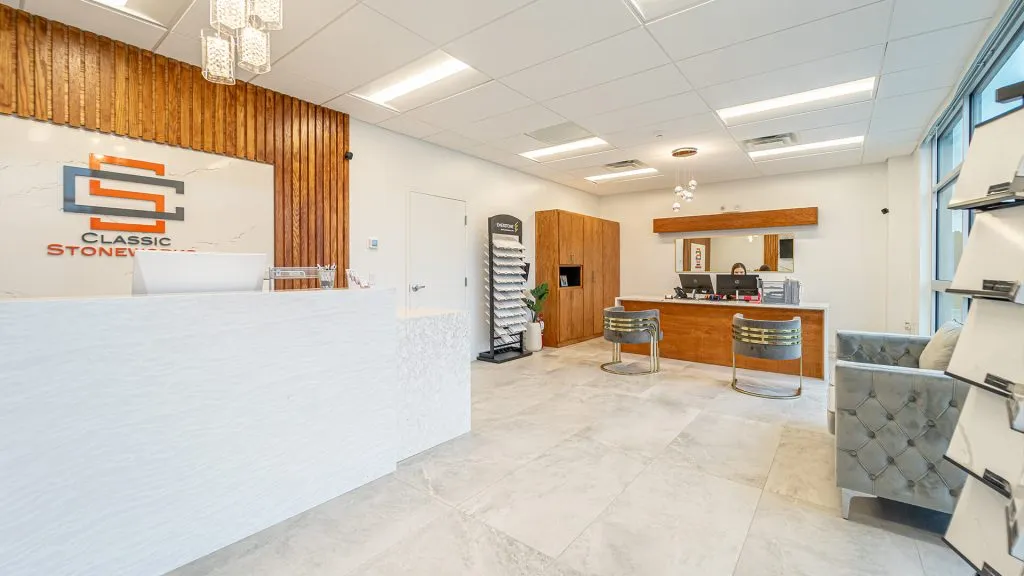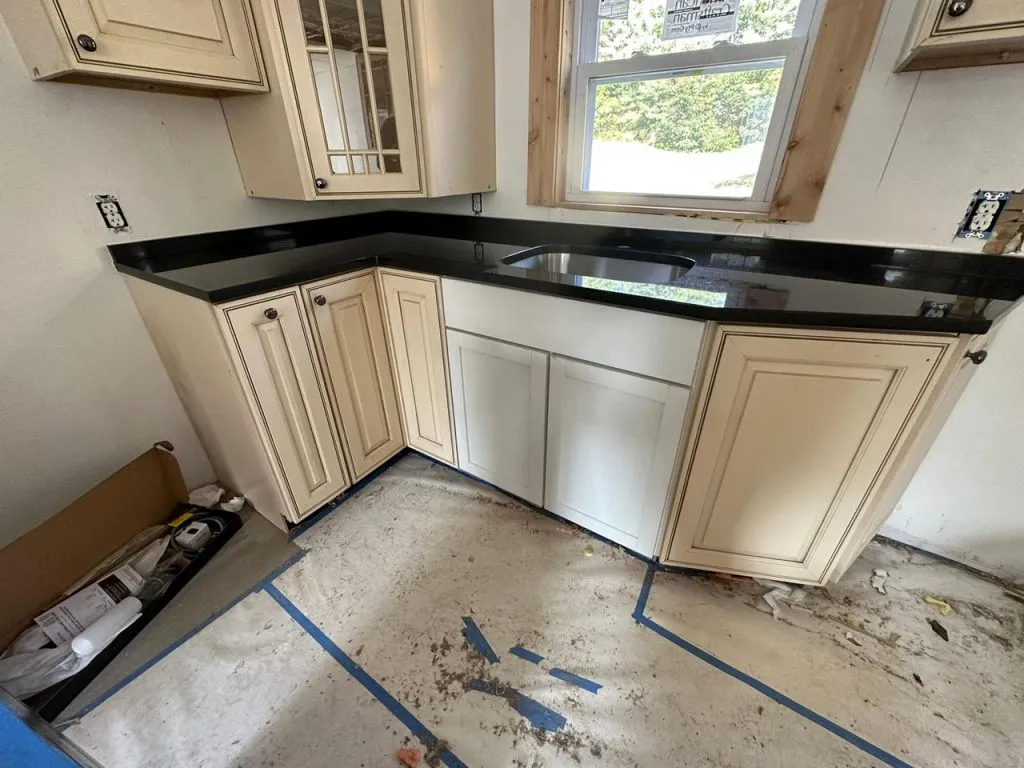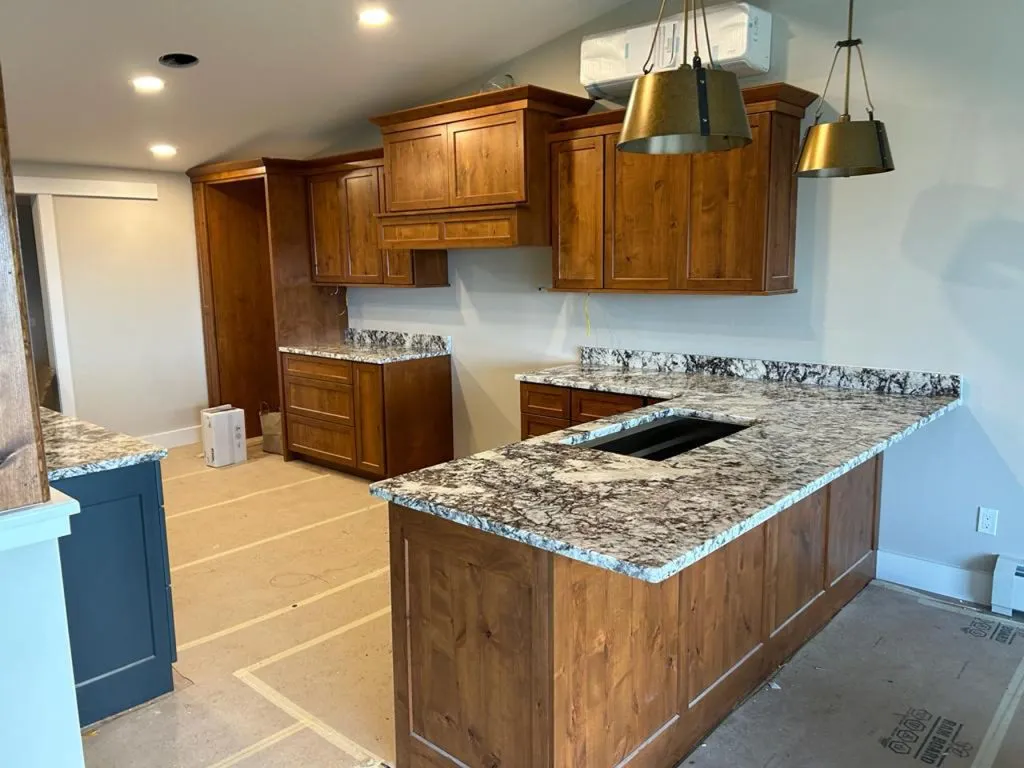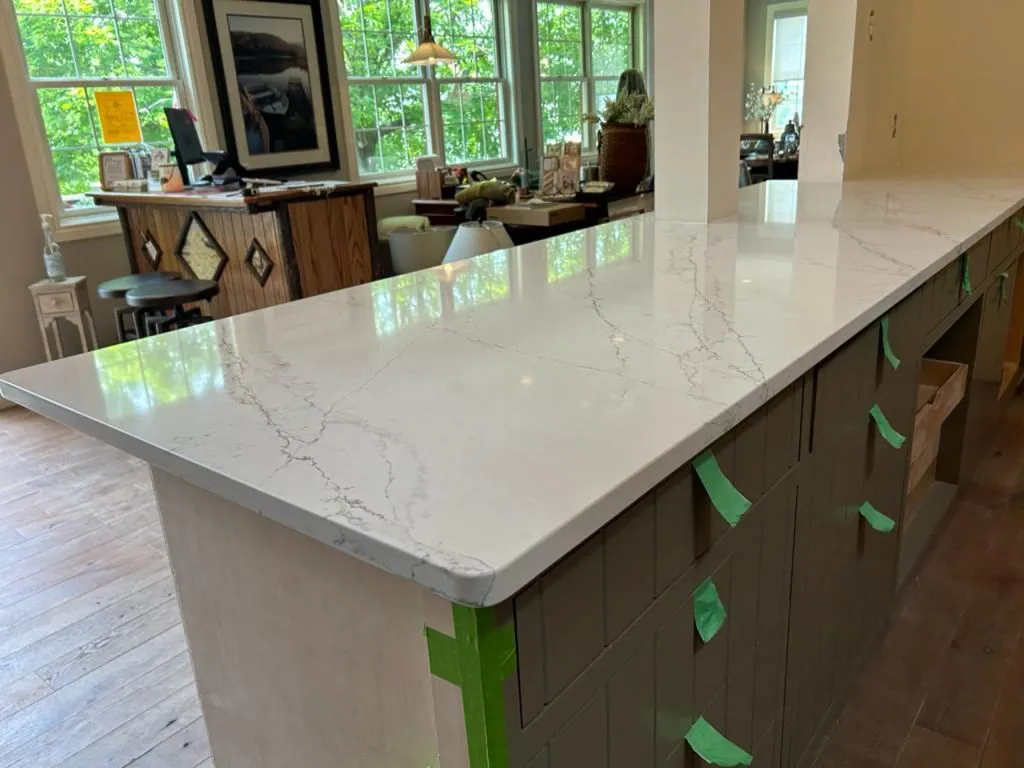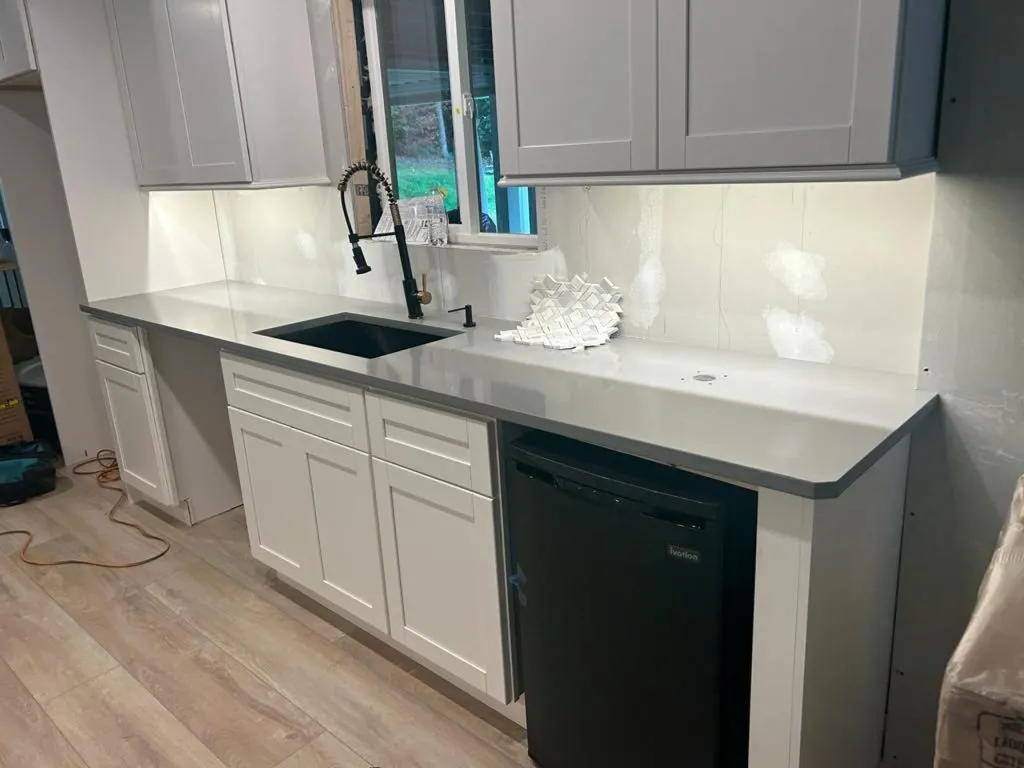
Fireplace surrounds can define the visual tone of a living room. More than decorative framing, they bring structure, scale, and material integrity to one of the most central architectural elements in the home.
Whether the fireplace is lit or not, the surround anchors the space and draws the eye, making it a key decision in any interior design project.
Natural stone is a preferred choice for fireplace surrounds in modern and classic homes. Marble introduces elegance with a soft polish. Granite provides a textured aesthetic. However, quartz also delivers consistency, and porcelain adds a refined surface that adapts well to contemporary layouts.
Each material interacts with light, proportion, and adjacent surfaces in a distinct way, creating depth and visual balance when used with intention.
The beauty of working with stone is that it creates presence and doesn’t compete with furniture or art.
With the right material and installation approach, fireplace surrounds can be architectural statements or quiet anchors, depending on the atmosphere you want to create.
This article explores how fireplace surrounds can elevate a living room through smart material selection, thoughtful design, and precision craftsmanship.
The role of fireplace surrounds in interior design
In well-planned interiors, no element is purely functional. Every line, material, and surface carries intention. Fireplace surrounds are a prime example of this principle.
Far from being a simple border, the surround defines the architectural rhythm of a living room and is often the visual anchor for the entire space.
Its location alone places it in a dominant position. Whether centered on a feature wall or integrated into a more open layout, the fireplace draws attention.
The surround reinforces that attention by framing the firebox with structure, texture, and scale. It creates a boundary between the raw utility of the fire and the curated environment around it.
Material selection is essential here. Stone fireplace surrounds introduce visual weight and timelessness that lighter materials often lack. Marble brings softness and elegance, granite adds density and contrast, quartz offers smooth continuity, and porcelain blends minimalism with refined surface detail.
The fireplace surround also connects design elements across the space. It relates to flooring, wall treatments, ceiling height, and even lighting. A well-executed surround brings cohesion to the room by establishing proportion and visual balance. In open-concept layouts, it can help define zones without using physical dividers.
Beyond style, the fireplace surrounds contribute to the atmosphere. It helps set the mood: grounded and warm, quiet and elegant, bold and architectural.
Choosing the right fireplace surround is an opportunity to express intention through architecture. It’s a focal point with the power to elevate the entire environment.
Popular stone materials for fireplace surrounds
The material choice directly impacts the tone, texture, and longevity of fireplace surrounds. Natural and engineered stones are the most requested surfaces for high-end living spaces.
Each material communicates something different through its pattern, finish, and interaction with light, and each one brings distinct benefits when used around the fireplace.
Marble
Marble is a classic choice for refinement and timeless appeal. Known for its soft veining and polished finish, marble lends a quiet sophistication to any room.
This stone pairs well with traditional millwork and modern architectural lines. Available in neutral palettes such as white, cream, or gray, marble supports an elevated, cohesive aesthetic without overwhelming the space.
Marble performs well in fireplace applications, especially in formal living rooms or spaces designed for entertaining. While softer than other stones, its visual richness and prestige make it a preferred material for focal-point installations.
Granite
Granite is selected for its density, durability, and bold visual presence. It offers more texture and color variation than marble, and its natural resilience makes it an excellent option for homes where fireplaces are used frequently.
Granite fireplace surrounds often feature deeper tones, ranging from charcoal to espresso, adding contrast and grounding lighter design schemes. Honed or leathered finishes can soften its appearance.
Quartz
Quartz is engineered for consistency, making it a strong choice for modern interiors prioritizing clean lines and controlled patterns. Its non-porous surface resists heat and staining, and it’s available in various colors and veining styles.
For clients who want a marble-like look with reduced maintenance, quartz delivers design flexibility without compromising on elegance. It integrates seamlessly into minimalist or transitional spaces.
Porcelain
Porcelain offers a sleek finish ideal for contemporary environments. With thin profiles and subtle texture options, it allows for full-wall applications and monolithic looks. Its resistance to heat and wear makes it practical and visually refined.
Porcelain fireplace surrounds work well when the goal is to create a seamless surface that feels light, sculptural, and quietly dramatic.
Comparison table
| Material | Visual style | Strengths | Best fit for |
| Marble | Soft veining, polished finish, timeless elegance | High visual impact, works well in classic and modern settings | Formal living rooms, statement pieces, refined interiors |
| Granite | Bold texture, natural variation, deeper tones | Heat-resistant, durable, adds contrast and grounding | Active fireplaces, high-use rooms, layered and earthy palettes |
| Quartz | Controlled patterns, clean lines, consistent coloration | Non-porous, low maintenance, heat and stain resistant | Minimalist spaces, transitional designs, families seeking practicality |
| Porcelain | Sleek, sculptural, thin profile with subtle texture options | Lightweight, heat- and wear-resistant, ideal for large surfaces | Contemporary interiors, full-wall surrounds, seamless visual flow |
Before choosing a material, it’s important to understand how each one will function and interact with the rest of the room.
Some clients prioritize natural variation and texture, while others prefer clean lines and easy upkeep. This comparison helps clarify which material suits the space visually and practically.
The next step is to look beyond the material and into how it is used. Proportion, placement, and finish are essential to ensure the fireplace surround becomes a cohesive architectural feature rather than a disconnected accent. Let’s explore how those design decisions come into play.
Design considerations – Proportion, placement, and finish in fireplace surrounds

Proportion, placement, and finish define how the surround interacts with the room. Each decision should be made with the space’s layout, scale, and function in mind.
Proportion
The fireplace surrounds’ dimensions should relate naturally to the wall it occupies and the elements around it. A surround that feels too narrow or shallow can appear disconnected, while one that dominates the space may overwhelm furniture and lighting.
Vertical height, mantel depth, and width relative to ceiling height and room scale all play a role. In rooms with high ceilings, a taller surround can create visual continuity. In smaller spaces, a lower profile with horizontal emphasis may feel more grounded and calm.
Placement
Placement is not always fixed. While many fireplaces are centered on a main wall, others are integrated into corners, partial dividers, or custom feature walls. The position of the surround should support sightlines, symmetry, and circulation. It should also relate clearly to furniture placement and lighting conditions.
Natural light, windows, and adjacent materials all influence how the stone will be perceived. A centered marble surround may reflect light and brighten the space. A dark granite frame in a corner installation may add depth and contrast without demanding visual dominance.
Finish
Finish defines texture, light reflection, and tactile quality. Polished stone offers clarity and formality, while honed or leathered finishes introduce softness and visual warmth. The right choice depends on the atmosphere you want to create.
A matte finish can help a fireplace blend into a minimal interior, while a polished surface may highlight it as the architectural centerpiece. Our approach is to consider aesthetics and maintenance when guiding clients through finish options.
When proportion, placement, and finish work together, the fireplace surrounds become a seamless part of the room’s architecture.
Bringing fireplace surrounds to life – The Classic Stoneworks approach

At Classic Stoneworks, we approach each project with a combination of technical accuracy and design sensitivity, translating inspiration into a finished surface that feels intentional and lasting.
Our work begins with a curated material selection. We help clients explore marble, granite, quartz, and porcelain options based on their design goals, lighting conditions, and surrounding finishes. Each slab is evaluated for color, veining, scale, consistency, and how it will interact with the other elements in the room.
Once the material is defined, we take detailed on-site measurements. Wall dimensions, ceiling lines, and structural details are documented to ensure a precise fit and clean alignment with millwork or built-ins. We assess wall flatness, floor transitions, and proportions that could influence visual balance.
In the fabrication phase, every cut is made with intention. If the veining direction or pattern flow is relevant, our team plans the layout to create continuity across the face of the surround. Edge treatments are finished to match the space’s aesthetic, whether the goal is sharp and modern or soft and traditional.
Installation is handled with equal care. The surround is positioned, leveled, and secured using industry-approved methods that preserve structural integrity and protect the material during handling. We verify alignment with adjacent walls, mantels, or recesses, and finish all visible surfaces to reflect the high standards expected in premium interior design.
Project Timeline – Fireplace Surround Installation Process
| Step | Description |
| 1. Material consultation | Clients are guided through curated options. Selections are made based on design goals, lighting, and surrounding finishes. |
| 2. Slab evaluation | Choices are aligned with spatial proportions and architectural details. |
| 3. On-site measurement | Precise measurements are taken to assess wall dimensions, ceiling lines, and surface flatness. |
| 4. Fabrication planning | The layout is planned to optimize veining direction and pattern flow. |
| 5. Fabrication execution | Stone is cut, shaped, and finished with precision. Seams, profiles, and transitions are prepared with alignment in mind. |
| 6. Installation | The surround is delivered and installed using secure, industry-approved methods. |
From the first consultation to the final clean-up, our process is built around clarity, communication, and attention to detail.
If you’re designing a fireplace surround and want a partner who values precision and aesthetics, Classic Stoneworks is prepared to guide, execute, and elevate every stage of the project.
Choose Classic Stoneworks for your fireplace surrounds’ installation!
Fireplace surrounds influence the atmosphere of the room, shape how the space is experienced, and are visual anchors that connect design, material, and function.
Whether working with a classic fireplace or planning a contemporary feature wall, the surround sets the tone.
Stone offers the ideal balance of performance and aesthetic value. Materials like marble, granite, quartz, and porcelain provide visual depth, texture, and durability.
When paired with thoughtful proportion, proper placement, and a finish matching the room’s character, the stone fireplace surrounds elevate the entire living environment.
At Classic Stoneworks, we combine technical expertise with aesthetic understanding to deliver fireplace surrounds that are precise, timeless, and integrated. From selecting the right slab to executing a clean installation, we guide every detail with purpose and consistency.
If you’re ready to transform your living room with a fireplace surround that feels considered and beautifully built, our team is here to help you define, refine, and bring it to life.
Contact Classic Stoneworks to begin your fireplace project!.





